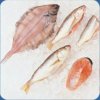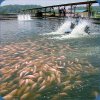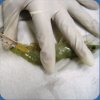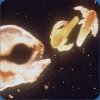 |
 |
 |
 |
 |
Evolutionary Morphology of Vertebrates
Department of Biology< Faculty of Sciences
Personnel
- Dominique Adriaens
- Tom Geerinckx
- Natalie De Schepper
- 6 PhD students
Activities
The research focus has since the ‘70s been the ontogeny of the head, as well as postcranial system, in bony fishes with special attention to the feeding apparatus and the locomotory system. The ontogenetic and evolutionary transformations of complex functional systems are the main field of interest of our research. Detailed anatomy of skeletal and soft tissue structures of all kinds of larval stages are studied relying on in toto clearing and staining, but also on serial histological sectioning, combined with complex graphical 3D-reconstructions. This methodology is used to look both at the morphology at the level of tissues (cf osteogenesis), as well as at the level of complex systems at a micro-scale (e.g. musculoskeletal system of the feeding apparatus at the smallest larval stages – figure on left shows 3D-reconstruction of cranial system in larval catfish ). All necessary infrastructures are currently present in the research group to generate histological series of large tissue blocks (such as complete fish). Studying the biology of shape changes is also one of the main research activities, where shape analyses are performed relying on landmark and outline based geometric morphometrics, both on the external morphology and the skeletal morphology.
Since recently, our research experience and methodology has also been applied in the field of applied ichthyology, as understanding the morphology and functioning of for example the feeding system in larval finfish is of great importance to improve larval quality in hatcheries. Also, shape analyses proved to be very useful for studying larval quality as well, as it enables a qualitative and quantitative screening of deformities occurring at early larval stages in cultivated fish. Current research has been focusing on larval development, growth and deformities in seabream (Sparus aurata – figure on right shows deoperculated larval seabream ) and seabass (Dicentrarchus labrax), which is performed in close collaboration with the Artemia Reference Centre.
Our major topics of research performed in collaboration with partners of the UGent Aquaculture R&D Center are:
- morphological development of larvae
- histology of musculoskeletal systems in larval fish
- qualitative and quantitative analysis of deformations in cultivated larval fish
Contact
- Websites
- email:
- tel: + 32 9 264 5219
- fax: + 32 9 264 5344
- Ma iling address:
- Evolutionary Morphology of Vertebrates, K.L. Ledeganckstraat 35, B-9000 Gent, Belgium

Laboratory of Aquaculture (Rozier 44 (tel: +32 (0)9 264.37.54 (fax: +32 (0)9 264.41.93

